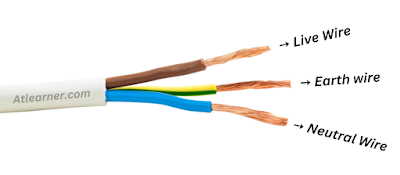One of the most significant innovations of all time is electricity. Nearly everything around us is powered by it, including machines, computers, and lights. However, there are also some risks associated with dealing with electricity.
Electrical wiring can be very intricate, especially when it comes to the live, neutral, and earthing wires. Anyone dealing with electricity or just trying to be safe around it needs to understand these electrical wire systems.
What is a Live Wire?
An electrical line that is carrying current is referred to as a "live wire". Usually, it is colored black, red, or brown to indicate that it is dangerous. In any electrical system, a live wire is a necessary wire, because it is responsible for carrying electricity from the source to the device being powered.
However, handling live wires is extremely risky because touching a live wire can result in electric shock, severe injuries, or even death.
Why is a Live Wire Dangerous?
A live wire is dangerous because it always has a current flowing through it. When electricity flows through a live wire, it generates an electric field around the wire. So in case of any contact with the wire, it can give an electric shock to anyone.
The intensity of the shock depends on several factors, including - the amount of current flowing through the wire, the length of time the current is applied, and the path of the current through the body.
Electric shock can cause a variety of health problems. These can range from burns and muscle contractions to more serious problems such as cardiac arrest or nerve damage. In some cases, electric shock can be extremely dangerous, and even death can happen.
How to Work with a Live Wire Safely
Working with a live wire requires careful attention to safety protocols to avoid accidents and injury. Some of the key safety considerations when working with a live wire include:
1. Use proper protective gear: Anyone working with a live wire should wear protective gear, including insulated gloves and footwear, to minimize the risk of electric shock.
2. Turn off the power: If possible, it is best to turn off the power to the circuit before working on the live wire. This can be done by shutting off the circuit breaker or disconnecting the power source.
3. Use insulated tools: Any tools used to work with a live wire should be insulated to prevent electric shock. This includes pliers, wire strippers, and screwdrivers.
4. Avoid touching the wire: It is essential to avoid touching the live wire when working on it. Use insulated tools to manipulate the wire, and make sure that all other conductive objects are far away from it.
5. Have a partner: It is always best to work with a partner when working with a live wire. This allows one person to handle the wire while the other person is ready to assist in case of an emergency.
What is a Neutral Wire?
The wire that completes the circuit and carries electricity back to the source is known as the "neutral wire". It typically has a white or blue color. The neutral wire is not dangerous because it does not carry current unless there is a problem with the circuit.
At the electrical service panel, the neutral wire is connected to the earth. This provides a low-resistance path for current to flow back to the source. Which helps to protect people and equipment from electrical shock.
What is Earthing Wire?
The earth wire, also known as the "ground wire", is an important safety feature in electrical systems. It typically has a green color or a green color with a yellow stripe. The earth wire offers a low-resistance path for current to flow to the earth. Which helps to protect people and equipment from electrical shock.
The earth wire is connected to the ground at the electrical service panel and also to any metal parts of the powered equipment. In case of any fault, it provides a path for current to flow to the earth. Which helps to prevent electric shock. The earth wire also helps to protect against lightning and other electrical surges.
Why these wires are important?
Conclusion: Live wires, neutral wires, and earth wires are all important components of an electrical system. Each wire serves a different purpose and is designed to protect people and equipment from electrical shock and other hazards.
Live wires are dangerous because they are always carrying current. They should always be handled with caution and should only be worked on by trained professionals.
Neutral wires are important because they complete the circuit and carry the electricity back to the source. They are not dangerous unless there is a problem with the circuit.
Earth wires are essential for safety. They provide a low-resistance path for current to flow to the earth, which helps to prevent electric shock and other hazards.
Continue Reading...


Post a Comment (0)